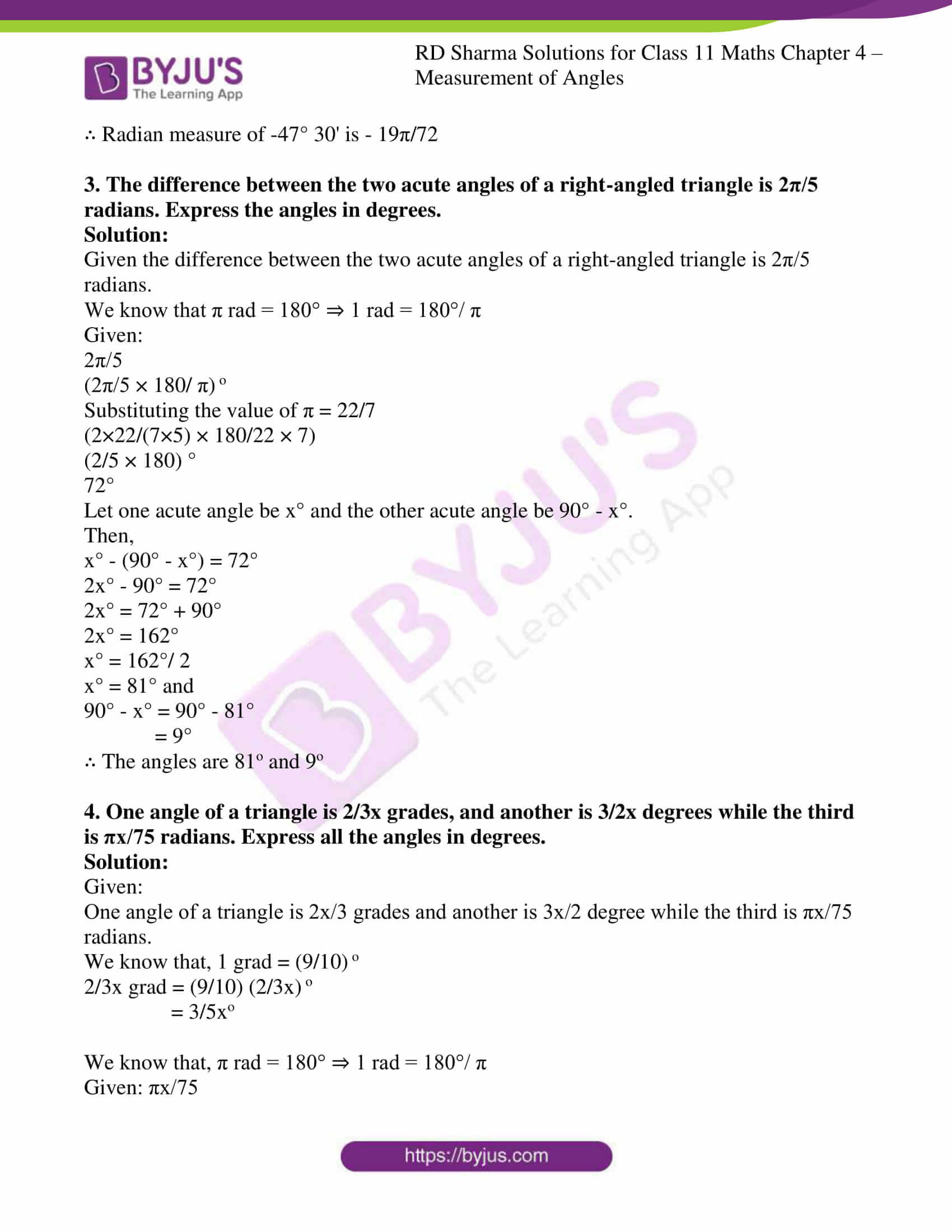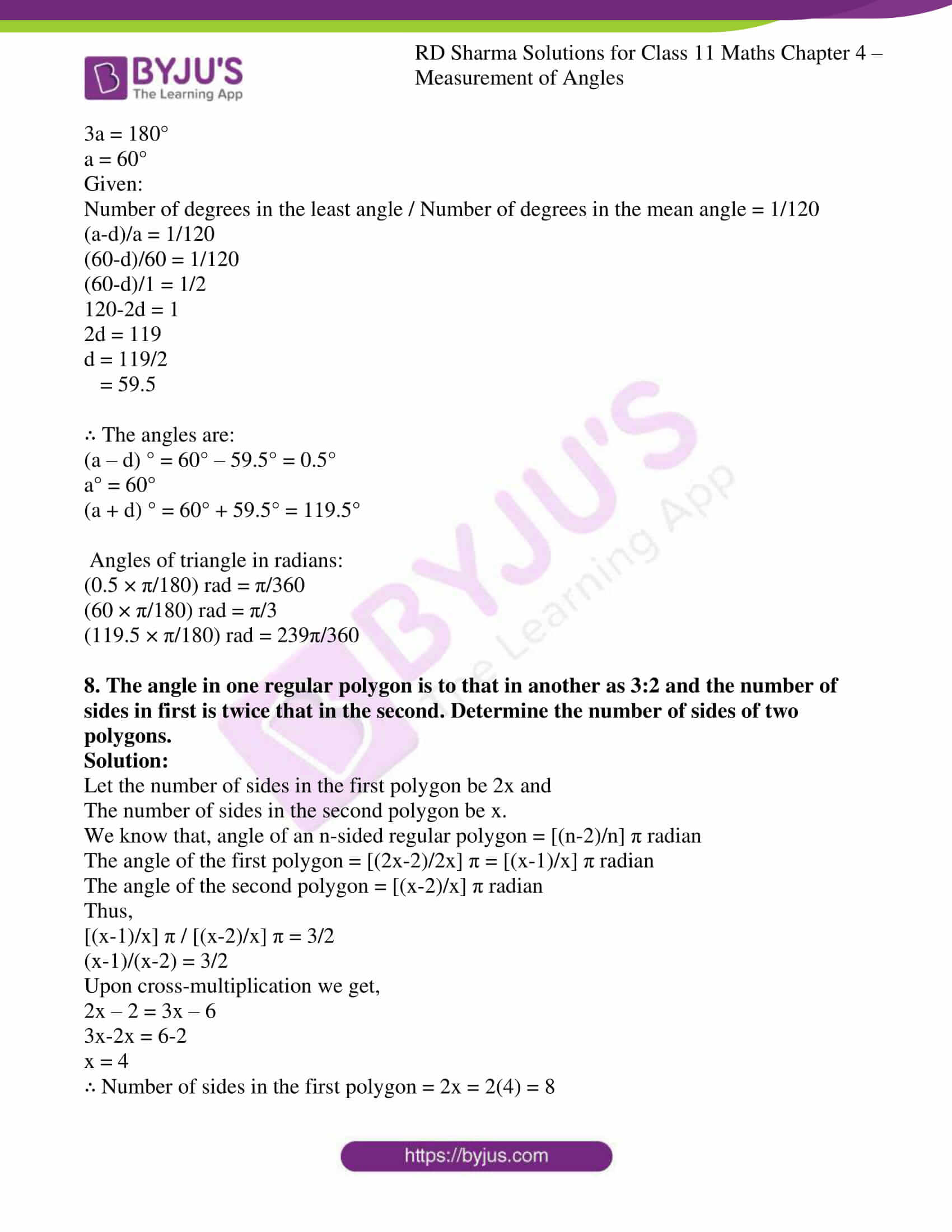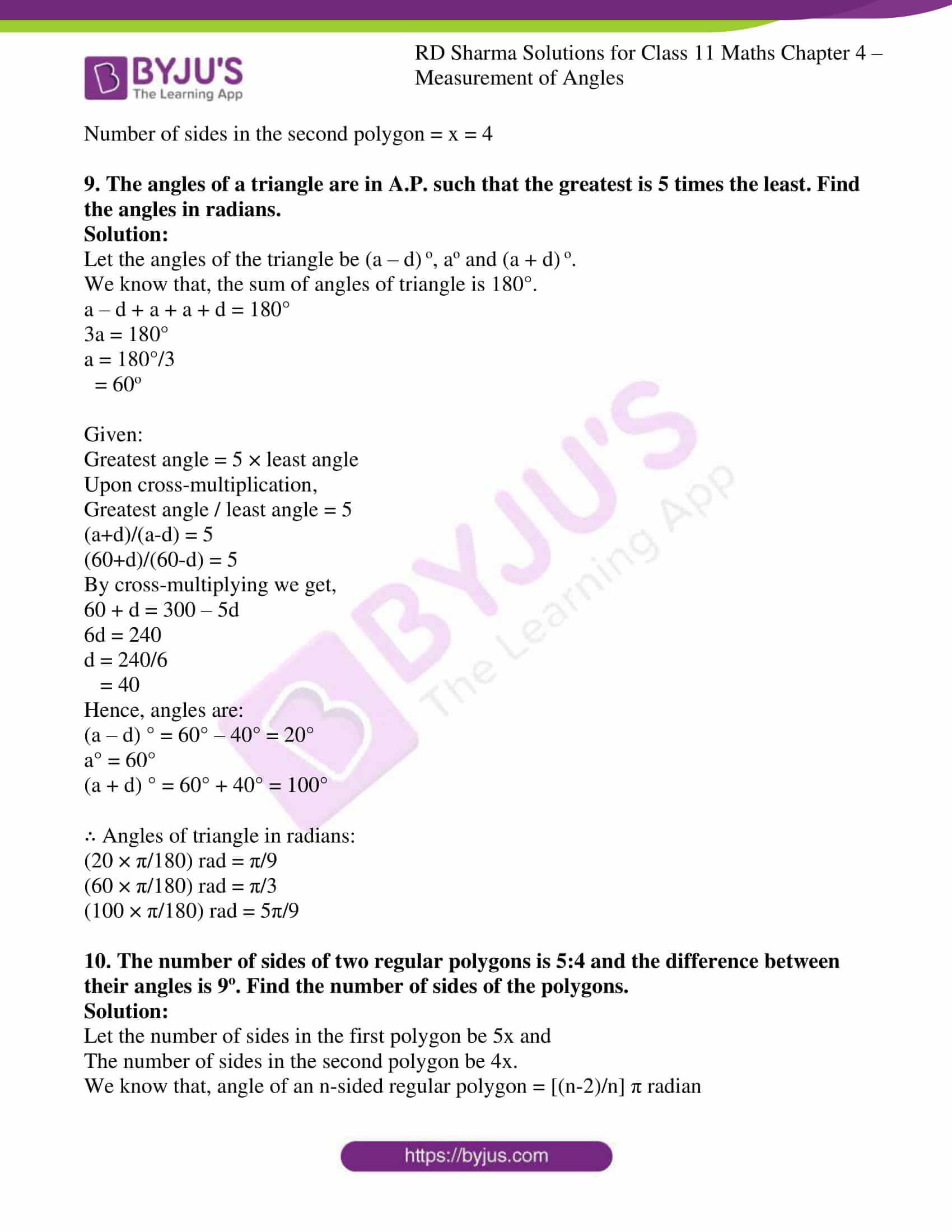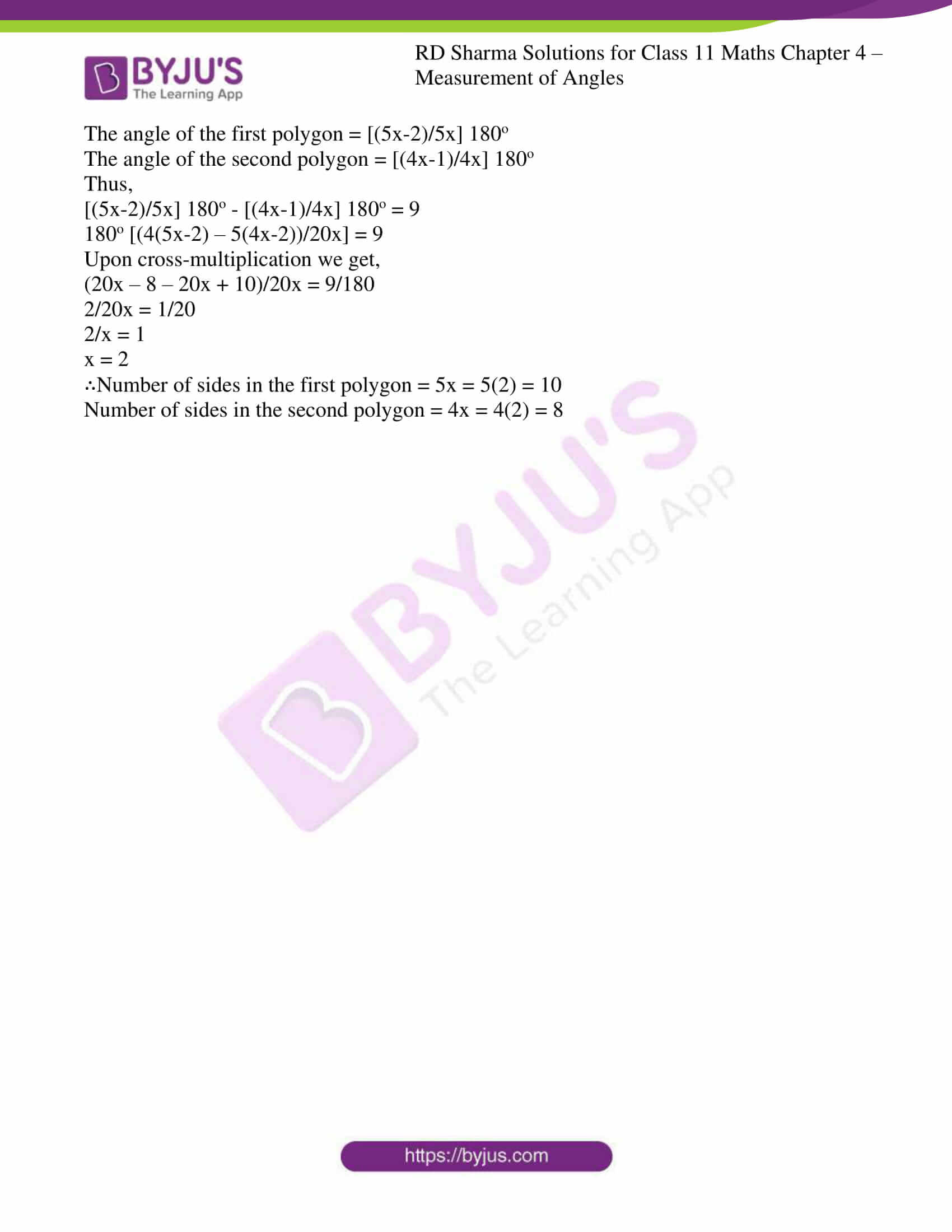RD Sharma Solutions Class 11 Maths Chapter 4 – Free PDF Download
RD Sharma Solutions for Class 11 Maths Chapter 4 – Measurement of Angles is provided here. We know that Trigonometry is a branch of Mathematics that deals with the measurement of the sides and the angles of a triangle and the problems allied with angles. In this chapter, we mostly learn about the relation between degrees, radians and real numbers. Expert tutors at BYJU’S have designed the RD Sharma Class 11 Solutions in order to help students to gain more knowledge and create a strong grip on the subject. Solutions to this chapter are provided in PDF format, which can be downloaded easily from the links provided below.
RD Sharma Solutions for Class 11 Maths Chapter 4 – Measurement of Angles contains one exercise, and students can find the precise answers to this exercise in RD Sharma Solutions. Now, let us have a look at the concepts discussed in this chapter.
- Angles.
- Some useful terms.
- Systems of measurement of angles.
- Sexagesimal system.
- Centesimal system.
- A circular system.
- The relation between degrees and radians.
- The relation between radians and real numbers.
- The relation between three systems of measurement of an angle.
RD Sharma Solutions for Class 11 Maths Chapter 4 – Measurement of Angles
Access answers to RD Sharma Solutions for Class 11 Maths Chapter 4 – Measurement of Angles
1. Find the degree measure corresponding to the following radian measures (Use π = 22/7)
(i) 9π/5 (ii) -5π/6 (iii) (18π/5) c (iv) (-3) c (v) 11c (vi) 1c
Solution:
We know that π rad = 180° ⇒ 1 rad = 180°/ π
(i) 9π/5
[(180/π) × (9π/5)] oSubstituting the value of π = 22/7
[180/22 × 7 × 9 × 22/(7×5)](36 × 9) °
324°
∴ Degree measure of 9π/5 is 324°
(ii) -5π/6
[(180/π) × (-5π/6)] oSubstituting the value of π = 22/7
[180/22 × 7 × -5 × 22/(7×6) ](30 × -5) °
– (150) °
∴ Degree measure of -5π/6 is -150°
(iii) (18π/5)
[(180/π) × (18π/5)] oSubstituting the value of π = 22/7
[180/22 × 7 × 18 × 22/(7×5)](36 × 18) °
648°
∴ Degree measure of 18π/5 is 648°
(iv) (-3) c
[(180/π) × (-3)] oSubstituting the value of π = 22/7
[180/22 × 7 × -3] o(-3780/22) o
(-171 18/22) o
(-171 o (18/22 × 60)’)
(-171o (49 1/11)’)
(-171o 49′ (1/11 × 60)’)
– (171° 49′ 5.45”)
≈ – (171° 49′ 5”)
∴ Degree measure of (-3) c is -171° 49′ 5”
(v) 11c
(180/ π × 11) o
Substituting the value of π = 22/7
(180/22 × 7 × 11) o
(90 × 7) °
630°
∴ Degree measure of 11c is 630°
(vi) 1c
(180/ π × 1) o
Substituting the value of π = 22/7
(180/22 × 7 × 1) o
(1260/22) o
(57 3/11) o
(57o (3/11 × 60)’)
(57o (16 4/11)’)
(57o 16′ (4/11 × 60)’)
(57o 16′ 21.81”)
≈ (57o 16′ 21”)
∴ Degree measure of 1c is 57o 16′ 21”
2. Find the radian measure corresponding to the following degree measures:
(i) 300o (ii) 35o (iii) -56o (iv)135o (v) -300o
(vi) 7o 30′ (vii) 125o 30’ (viii) -47o 30′
Solution:
We know that 180° = π rad ⇒ 1° = π/ 180 rad
(i) 300°
(300 × π/180) rad
5π/3
∴ Radian measure of 300o is 5π/3
(ii) 35°
(35 × π/180) rad
7π/36
∴ Radian measure of 35o is 7π/36
(iii) -56°
(-56 × π/180) rad
-14π/45
∴ Radian measure of -56° is -14π/45
(iv) 135°
(135 × π/180) rad
3π/4
∴ Radian measure of 135° is 3π/4
(v) -300°
(-300 × π/180) rad
-5π/3
∴ Radian measure of -300° is -5π/3
(vi) 7° 30′
We know that, 30′ = (1/2) °
7° 30′ = (7 1/2) °
= (15/2) o
= (15/2 × π/180) rad
= π/24
∴ Radian measure of 7° 30′ is π/24
(vii) 125° 30′
We know that, 30′ = (1/2) °
125° 30’ = (125 1/2) °
= (251/2) o
= (251/2 × π/180) rad
= 251π/360
∴ Radian measure of 125° 30′ is 251π/360
(viii) -47° 30′
We know that, 30′ = (1/2) °
-47° 30’ = – (47 1/2) °
= – (95/2) o
= – (95/2 × π/180) rad
= – 19π/72
∴ Radian measure of -47° 30′ is – 19π/72
3. The difference between the two acute angles of a right-angled triangle is 2π/5 radians. Express the angles in degrees.
Solution:
Given the difference between the two acute angles of a right-angled triangle is 2π/5 radians.
We know that π rad = 180° ⇒ 1 rad = 180°/ π
Given:
2π/5
(2π/5 × 180/ π) o
Substituting the value of π = 22/7
(2×22/(7×5) × 180/22 × 7)
(2/5 × 180) °
72°
Let one acute angle be x° and the other acute angle be 90° – x°.
Then,
x° – (90° – x°) = 72°
2x° – 90° = 72°
2x° = 72° + 90°
2x° = 162°
x° = 162°/ 2
x° = 81° and
90° – x° = 90° – 81°
= 9°
∴ The angles are 81o and 9o
4. One angle of a triangle is 2/3x grades, and another is 3/2x degrees while the third is πx/75 radians. Express all the angles in degrees.
Solution:
Given:
One angle of a triangle is 2x/3 grades and another is 3x/2 degree while the third is πx/75 radians.
We know that, 1 grad = (9/10) o
2/3x grad = (9/10) (2/3x) o
= 3/5xo
We know that, π rad = 180° ⇒ 1 rad = 180°/ π
Given: πx/75
(πx/75 × 180/π) o
(12/5x) o
We know that, the sum of the angles of a triangle is 180°.
3/5xo + 3/2xo + 12/5xo = 180o
(6+15+24)/10xo = 180o
Upon cross-multiplication we get,
45xo = 180o × 10o
= 1800o
xo = 1800o/45o
= 40o
∴ The angles of the triangle are:
3/5xo = 3/5 × 40o = 24o
3/2xo = 3/2 × 40o = 60o
12/5 xo = 12/5 × 40o = 96o
5. Find the magnitude, in radians and degrees, of the interior angle of a regular:
(i) Pentagon (ii) Octagon (iii) Heptagon (iv) Duodecagon.
Solution:
We know that the sum of the interior angles of a polygon = (n – 2) π
And each angle of polygon = sum of interior angles of polygon / number of sides
Now, let us calculate the magnitude of
(i) Pentagon
Number of sides in pentagon = 5
Sum of interior angles of pentagon = (5 – 2) π = 3π
∴ Each angle of pentagon = 3π/5 × 180o/ π = 108o
(ii) Octagon
Number of sides in octagon = 8
Sum of interior angles of octagon = (8 – 2) π = 6π
∴ Each angle of octagon = 6π/8 × 180o/ π = 135o
(iii) Heptagon
Number of sides in heptagon = 7
Sum of interior angles of heptagon = (7 – 2) π = 5π
∴ Each angle of heptagon = 5π/7 × 180o/ π = 900o/7 = 128o 34′ 17”
(iv) Duodecagon
Number of sides in duodecagon = 12
Sum of interior angles of duodecagon = (12 – 2) π = 10π
∴ Each angle of duodecagon = 10π/12 × 180o/ π = 150o
6. The angles of a quadrilateral are in A.P., and the greatest angle is 120o. Express the angles in radians.
Solution:
Let the angles of quadrilateral be (a – 3d) °, (a – d) °, (a + d) ° and (a + 3d) °.
We know that, the sum of angles of a quadrilateral is 360°.
a – 3d + a – d + a + d + a + 3d = 360°
4a = 360°
a = 360/4
= 90°
Given:
The greatest angle = 120°
a + 3d = 120°
90° + 3d = 120°
3d = 120° – 90°
3d = 30°
d = 30°/3
= 10o
∴ The angles are:
(a – 3d) ° = 90° – 30° = 60°
(a – d) ° = 90° – 10° = 80°
(a + d) ° = 90° + 10° = 100°
(a + 3d) ° = 120°
Angles of quadrilateral in radians:
(60 × π/180) rad = π/3
(80 × π/180) rad = 4π/9
(100 × π/180) rad = 5π/9
(120 × π/180) rad = 2π/3
7. The angles of a triangle are in A.P., and the number of degrees in the least angle is to the number of degrees in the mean angle as 1:120. Find the angle in radians.
Solution:
Let the angles of the triangle be (a – d) °, a° and (a + d) °.
We know that, the sum of the angles of a triangle is 180°.
a – d + a + a + d = 180°
3a = 180°
a = 60°
Given:
Number of degrees in the least angle / Number of degrees in the mean angle = 1/120
(a-d)/a = 1/120
(60-d)/60 = 1/120
(60-d)/1 = 1/2
120-2d = 1
2d = 119
d = 119/2
= 59.5
∴ The angles are:
(a – d) ° = 60° – 59.5° = 0.5°
a° = 60°
(a + d) ° = 60° + 59.5° = 119.5°
Angles of triangle in radians:
(0.5 × π/180) rad = π/360
(60 × π/180) rad = π/3
(119.5 × π/180) rad = 239π/360
8. The angle in one regular polygon is to that in another as 3:2 and the number of sides in first is twice that in the second. Determine the number of sides of two polygons.
Solution:
Let the number of sides in the first polygon be 2x and
The number of sides in the second polygon be x.
We know that, angle of an n-sided regular polygon = [(n-2)/n] π radian
The angle of the first polygon = [(2x-2)/2x] π = [(x-1)/x] π radian
The angle of the second polygon = [(x-2)/x] π radian
Thus,
[(x-1)/x] π / [(x-2)/x] π = 3/2(x-1)/(x-2) = 3/2
Upon cross-multiplication we get,
2x – 2 = 3x – 6
3x-2x = 6-2
x = 4
∴ Number of sides in the first polygon = 2x = 2(4) = 8
Number of sides in the second polygon = x = 4
9. The angles of a triangle are in A.P. such that the greatest is 5 times the least. Find the angles in radians.
Solution:
Let the angles of the triangle be (a – d) o, ao and (a + d) o.
We know that, the sum of angles of triangle is 180°.
a – d + a + a + d = 180°
3a = 180°
a = 180°/3
= 60o
Given:
Greatest angle = 5 × least angle
Upon cross-multiplication,
Greatest angle / least angle = 5
(a+d)/(a-d) = 5
(60+d)/(60-d) = 5
By cross-multiplying we get,
60 + d = 300 – 5d
6d = 240
d = 240/6
= 40
Hence, angles are:
(a – d) ° = 60° – 40° = 20°
a° = 60°
(a + d) ° = 60° + 40° = 100°
∴ Angles of triangle in radians:
(20 × π/180) rad = π/9
(60 × π/180) rad = π/3
(100 × π/180) rad = 5π/9
10. The number of sides of two regular polygons is 5:4 and the difference between their angles is 9o. Find the number of sides of the polygons.
Solution:
Let the number of sides in the first polygon be 5x and
The number of sides in the second polygon be 4x.
We know that, angle of an n-sided regular polygon = [(n-2)/n] π radian
The angle of the first polygon = [(5x-2)/5x] 180o
The angle of the second polygon = [(4x-1)/4x] 180o
Thus,
[(5x-2)/5x] 180o – [(4x-1)/4x] 180o = 9180o [(4(5x-2) – 5(4x-2))/20x] = 9
Upon cross-multiplication we get,
(20x – 8 – 20x + 10)/20x = 9/180
2/20x = 1/20
2/x = 1
x = 2
∴Number of sides in the first polygon = 5x = 5(2) = 10
Number of sides in the second polygon = 4x = 4(2) = 8
Frequently Asked Questions on RD Sharma Solutions for Class 11 Maths Chapter 4
Why should we learn all the concepts present in RD Sharma Solutions for Class 11 Maths Chapter 4?
List out the important topics present in RD Sharma Solutions for Class 11 Maths Chapter 4.
The topics covered in RD Sharma Solutions for Class 11 Maths Chapter 4 are listed below:
- Angles.
- Some useful terms.
- Systems of measurement of angles.
- Sexagesimal system.
- Centesimal system.
- A circular system.
- The relation between degrees and radians.
- The relation between radians and real numbers.
- The relation between three systems of measurement of an angle.
These concepts are important from an exam perspective. It is strictly based on the latest syllabus of the CBSE and also depends on the CBSE question paper design and marking scheme.









Comments